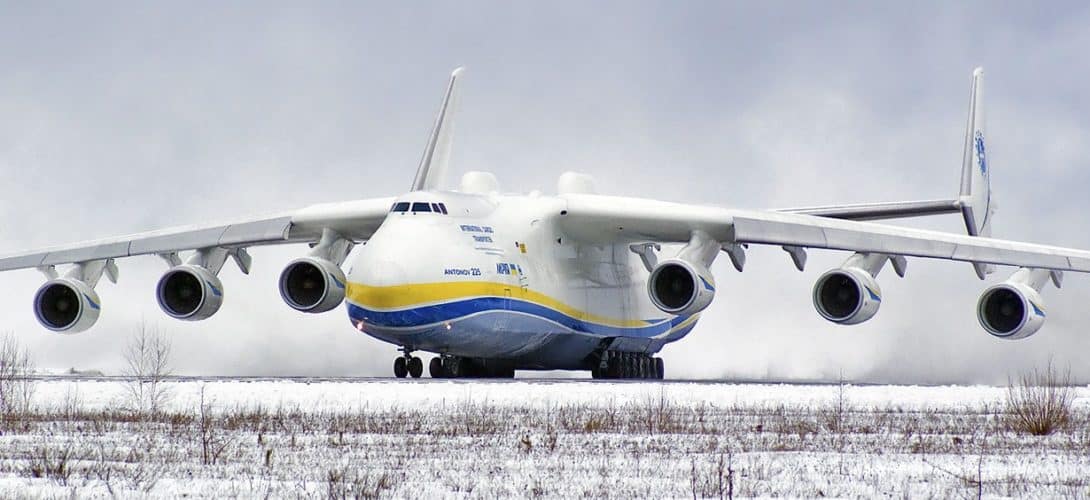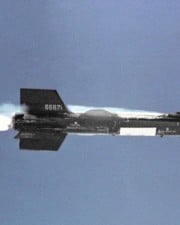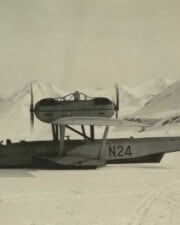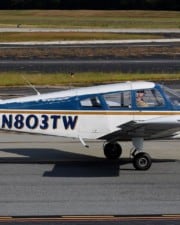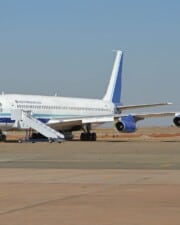With four engine aircraft (sometimes called “quadjets”) becoming increasingly rare, six engine aircraft are something of a novelty. Indeed, there have been comparatively fewer six engine aircraft than two, three and four engine aircraft.
Six engine aircraft began to emerge nearing the end of the 1930s. Initially, they were designed to help bridge the gap between piston aircraft and the then-still somewhat unreliable turboprops, by giving piston aircraft the range and cruise speed to match their turboprop counterparts.
As more reliable jet engines were developed throughout the early 1950s and 1960s, the six engine layout pioneered in previous decades was revived, making way for huge aircraft with huge payload capacities and globetrotting ranges.
To date, only about 40 different six engine aircraft have been built. Some of these never left the prototype phase, whilst others still were canceled just before mass production was to take place. All in all, only a few were lucky to ever enter mass production. But which are the best?
7. North American XB-70 Valkyrie
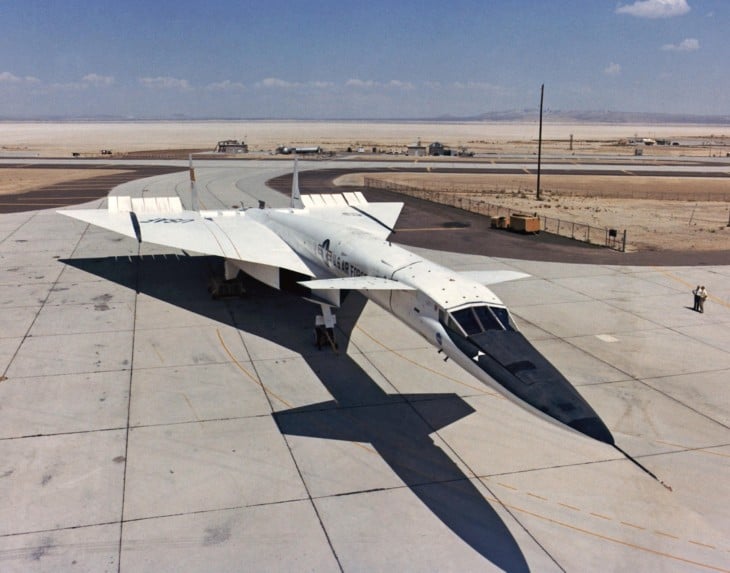
Originally designed as a high-altitude, Mach 3+ capable, nuclear-armed bomber, the XB-70 program was canceled before the first prototype was even built. Despite this, North American pressed forward with the project.
Now repurposed for life as an experimental aircraft for testing the aerodynamics and propulsion of supersonic aircraft, many areas of the bomber were completely redesigned ahead of the first prototype rolling off the assembly line floor.
The once-fearsome bomb bays were converted into places for extra sensors and fuel tanks. The cockpit was similarly overhauled, removing the now-redundant bombardier and navigator seats, to make way for more flight instruments (and yes, even more sensors).
Initially used by the USAF (in conjunction with the FAA) for testing to see how creating sonic booms overland from commercial supersonic transports (SSTs) would affect critical infrastructure, the XB-70 was eventually delivered to a joint USAF-NASA team in November 1966.
Performing a number of tests on everything from how fast the XB-70 could go, to whether the addition of two small vanes on the nose of supersonic aircraft improved stability, the data gathered formed the basis of supersonic aircraft design for the next decade.
Indeed, data gathered from these test flights directly influenced the designs of the Boeing 2707, B-1 Lancer and Tupolev Tu-144 (through espionage, hence the canards on both aircraft). Through this, the Valkyrie was arguably the most important aircraft in the race to build the fastest supersonic aircraft.
6. Saunders-Roe Princess
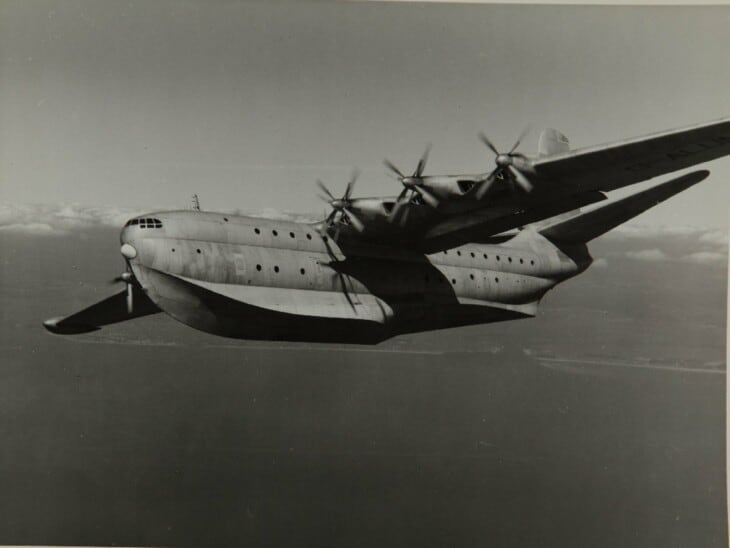
Known for being the last aircraft built by Saunders-Roe before its forced merger into Westland Aircraft (known as Westland Helicopters following the merger), the aptly-named Princess was one of the best airliners that never flew.
Designed and built during the initial postwar period, the Princess holds the distinction of being the world’s largest all-metal flying boat, by all metrics including length, wingspan and MTOW.
In fact, the Princess was so large that it had to be partially built outside because the hangars at the Saunders-Roe headquarters on the Isle of Wight were too small to accommodate the behemoth that was the SR.45 Princess!
When the first prototype was finally finished in mid-1952, its MTOW measured in at a whopping 345,025 lb (156,501 kg), second only to the American-made H-4 Hercules. It was also the largest aircraft employing gas turbines for its six Bristol Proteus turboprop engines.
Among the largest in an aircraft class that were famously low-flying, cold, unpressurized and somewhat difficult to control (both in the air and on water), the Princess did away with many of these.
It was the first British-built aircraft to have hot and cold air conditioning and power-operated irreversible flying controls, whilst also being one of the first to have hull pressurization – thanks to its “double-bubble” double-deck fuselage design.
Even as new jet-powered airliners were killing off other postwar flying boat designs, the Princess changed tack, trying to market itself as a huge military troop transport or commercial cargo aircraft.
Militaries and cargo operators from the British Empire and beyond showed considerable interest in the Princess in both configurations, though no one ever made a firm commitment and the Princess was mothballed in the mid-1950s.
5. Blohm & Voss BV 238

Designed to be able to transport Nazi high command to South America in the event of a German defeat, the BV 238 was massive to say the least.
At the time of its first flight in 1944, it was the heaviest aircraft in the world, the largest aircraft any of the Axis powers had built, and had the fourth-longest wingspan of any aircraft up until that point. Certainly impressive feats.
But that’s not what made it so famous: its armament did. In the scenarios German High Command ran whilst designing the BV 238, Germany was on its last legs. It had no Luftwaffe or Kriegsmarine to protect them and the Wehrmacht was pushed back all the way to Berlin.
As such, the BV 238 would have to not only fly itself out of Germany with the country’s leadership onboard, it would have to do so alone with enemies on all sides.
This necessitated the installation of 20 high-powered 13 mm (0.512 in) machine guns and two 20 mm (0.787 in) autocannons around the aircraft, giving it a 360 degree field of fire.
In addition to this, the wings were so large they could hold 20 250 kg (550 lb) bombs internally and up to 4,000 kg (8,800 lb) of bombs, missiles or torpedoes externally. By all accounts, the BV 238 was a literal flying fortress.
So this perhaps explains why when the Allies invaded mainland Germany, both British and American forces attacked Lake Schaal with the sole purpose of destroying it. Though it was sunk in 1945, nobody knows who exactly sunk it, as both the British and Americans claim to have sunk it.
Even after the war, the (Western) Allies refused to allow German authorities to dredge the wreckage, finish either or the two remaining unfinished prototypes or build another BV 238 from scratch due to the fear that it could be used against them once again, even during the 1960s.
4. Convair B-36 Peacemaker
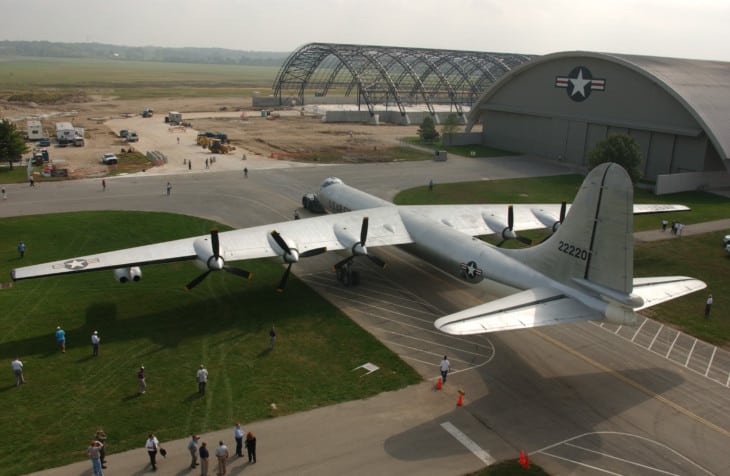
Developed during WWII as a hedge against the possibility of Britain surrendering, the B-36 was in a league of its own when it came to the sheer size of it and its range.
Easily dwarfing any other aircraft the US military had, in terms of size, at that time, the B-36 was designed for, and capable of, flying non-stop from the Eastern Seaboard to Europe and back; an almost unheard of feat during the early 1940s.
The only other aircraft of that nature in development at that time was the Amerikabomber then-under development in Germany, interestingly designed for a similar purpose by the Nazis for when they defeated the British. Unlike the B-36, however, the Amerikabomber never left the design stage.
Indeed, its sheer size prolonged development to the extent that the B-36 wasn’t ready until after the war. But that didn’t mean its service life was over before it began.
Reimagined as a long-range nuclear bomber, the B-36 – now given the name “Peacemaker” – became the first aircraft capable of delivering any of the nuclear weapons in the US military’s growing arsenal, and the primary nuclear strike bomber from 1948 until 1955.
Interestingly, despite its first flight having taken place well over 75 years ago, back in August 1946, the B-36 still holds two titles: the largest mass-produced piston aircraft and the longest wingspan of any combat aircraft built to date (at 230 ft/70 m)!
3. Boeing B-47 Stratojet
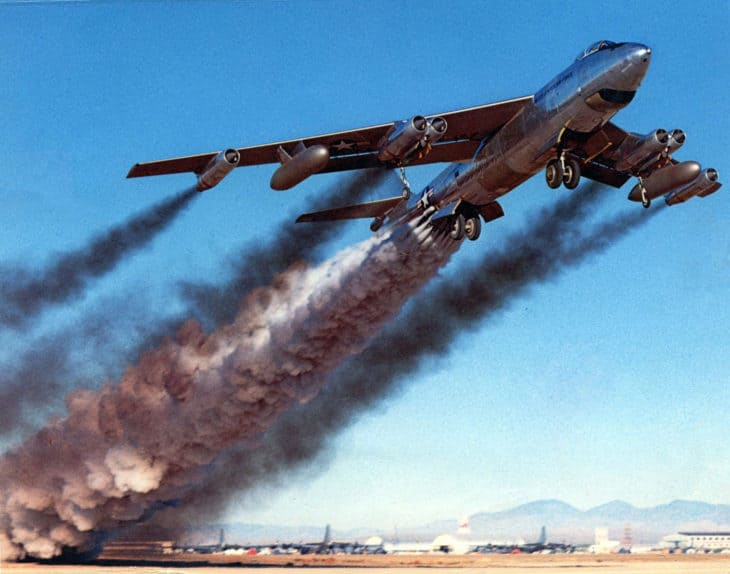
Though overshadowed by its more famous cousin, the B-52 Stratofortress, the six engine B-47 Stratojet was arguably an even greater aircraft, even if its 30 year service history is nothing compared to the nearly 70 year service history of the Stratofortress.
Despite the Stratojet’s shorter service life, it holds the distinction of being the world’s most produced jet-powered bomber.
At over 2,000 examples (built between 1947 and 1955), there were significantly more Stratojets built than the next most produced jet bomber, the Tu-16 at a little over 1500 examples. But Boeing and the USAF didn’t just go for quantity over quality when building the Stratojet.
Originally just a strategic bomber, it wasn’t long until both Boeing and the USAF saw another potential use for the Stratojet: Reconnaissance.
First used as a weather reconnaissance aircraft due to its in-flight stability, the Stratojet was later developed as one of the first true Electronic Signals Intelligence (ELINT) aircraft. Leading on from that, another variant of the Stratojet was developed for electronic warfare too.
One Stratojet was even modified by Canadair (and given the designation of the CL-52) before being loaned to the Royal Canadian Air Force (RCAF) to test the new Orenda Iroquois engines for the then-in development CF-105 Arrow.
And test flying didn’t just end there. In 1953, the Stratojet was used as a testbed for air-to-air refueling (probe-and-drogue method). Other test flying included a brief foray into mixed propulsion (jet and turboprop) and as a launcher for air-to-air missiles.
2. Scaled Composites Stratolaunch

Looking at the Stratolaunch, you’d be forgiven for thinking that it was some kind of experimental aircraft from the early Jet Age. You’d even be partially correct.
Though the prototype has been finished, and the Stratolaunch has flown a number of successful flights for commercial customers in addition to its test flights, it still looks very much like an experimental aircraft.
Part of this is due to its design, which features both a twin fuselage and twin empennage (courtesy of it being the brainchild of Microsoft co-founder, Paul Allen). Part of this is also due to its intended use as a mothership aircraft for launching air-launch-to-orbit (ALTO) rockets.
Due to this rather unique design and intended use, the Stratolaunch is among the largest aircraft in the world by its sheer size. Indeed, measuring over 238 ft (73 m) in length, it is longer than even the mighty Airbus A380!
And it doesn’t end there. To do its intended job, the Stratolaunch has an MTOW of 1,300,000 lb (589,670 kg), second only to the aforementioned An-225 Mriya, and the longest wingspan of any aircraft ever at an astonishing 385 ft (117 m)!
To put this in perspective, it has an MTOW roughly equivalent to the weight of 1,000 grand pianos and a wingspan a little over three times the length of the Wright Brothers’ first flight back in 1903.
Perhaps this is why the Stratolaunch’s designers nicknamed it the “Roc” after the mythical Arabian bird (sometimes referred to as “Sinbad’s Roc”) that was so large it could carry an elephant.
1. Antonov An-225 Mriya
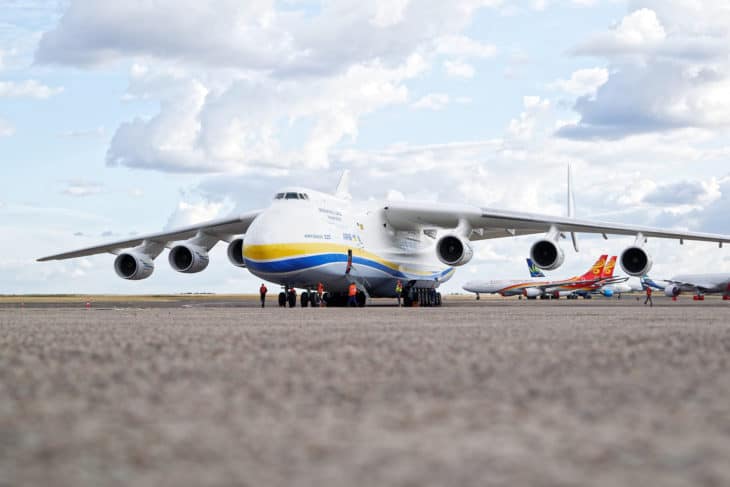
Affectionately named the Mriya, the Ukrainian word meaning “Dream”, the An-225 was developed by Ukraine-based Antonov during the Soviet era as an even larger aircraft than its already large An-124 Ruslan aircraft.
Indeed, the Mriya was so large that it remains one of the largest aircraft ever built to this day, and holds a number of other world records; chiefly that it has the highest MTOW ever, as well as the longest wingspan of any aircraft currently in service.
Other records the Mriya holds include:
- Holding the highest altitude art exhibition (September 27 2012; 10,150 m (33,301 ft) during the AviaSvit-XX1 Aerospace Show)
- Carrying the world’s longest piece of cargo by air (June 11 2010; 42.1 m (138 ft)-long wind turbine blades)
- Carrying the world’s single heaviest piece of cargo by air (August 11 2009; a gas power generator weighing 189,980 kg (418,830 lb) bound for Armenia)
- Flying the world’s heaviest cargo flight (September 11 2001; four tanks weighing 253.82 tonnes)
Aside from this ability to set, and ultimately hold, records for decades on end, the Mriya was also central to the Soviet space program. Even China has expressed interest on several occasions about using the Mriya for their space program!
Due in part to its sheer size, as well as its status as a national symbol and revenue generator for the country, Ukraine has vowed to rebuild the Mriya in the wake of its destruction in 2022, perhaps marking a future for the once-famous aircraft.
Related Posts
